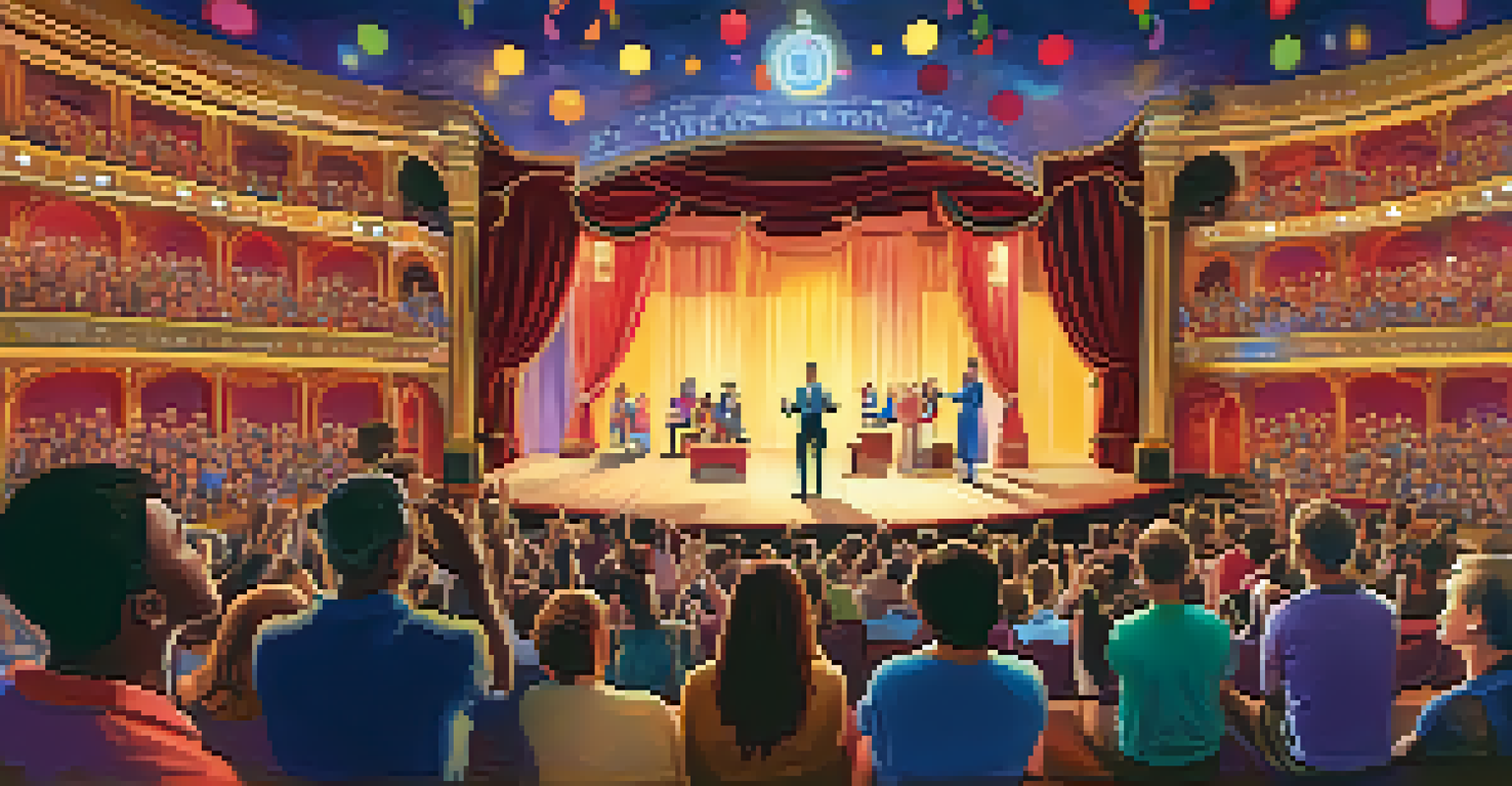The Role of Emotion in Performance Art: Connecting with Audiences

Understanding the Emotional Core of Performance Art
At the heart of every performance art piece lies an emotional core that drives the narrative. This emotional connection not only captivates the audience but also serves as a vehicle for expression and communication. Artists tap into their own feelings, experiences, and perceptions, creating a tapestry of emotions that resonate with viewers on a personal level.
Art is the most beautiful of all lies; it is the most beautiful way to express the truth of our existence.
For instance, a dancer may express joy through fluid movements or convey sorrow through a slow, heavy style. These physical embodiments of emotion invite audiences to not just observe but to feel, creating a bridge between performer and viewer. This emotional exchange is what turns a routine performance into a memorable experience.
Ultimately, understanding this emotional core helps both artists and audiences appreciate the depth of performance art. It highlights the importance of vulnerability and authenticity, fostering a space where raw human emotion can be shared and experienced collectively.
The Power of Vulnerability in Performance
Vulnerability can be a potent tool in performance art, allowing artists to connect with their audience on a deeper level. When performers share their fears, struggles, or triumphs openly, they invite the audience to engage beyond surface-level appreciation. This raw honesty often evokes empathy, making the experience more relatable and impactful.

Consider a spoken word artist who shares a personal story of overcoming adversity. The audience not only hears the words but feels the emotions behind them, fostering a sense of shared experience. This connection can be transformative, as it encourages viewers to reflect on their own journeys and emotions.
Emotions Drive Performance Art
At the core of performance art lies an emotional connection that captivates audiences and enhances the overall experience.
In this way, vulnerability becomes a catalyst for connection. It encourages a dialogue between the performer and audience, creating a communal experience that lingers long after the performance ends.
Emotional Storytelling: Crafting a Narrative
Storytelling is a fundamental aspect of performance art, and emotions play a crucial role in crafting compelling narratives. Artists weave their experiences, thoughts, and feelings into narratives that resonate with audiences, often using emotional peaks and valleys to enhance engagement. This deliberate structure helps to guide viewers through a journey of emotional highs and lows.
The role of the artist is to make the human being uncomfortable. That's how we evolve.
For example, a theatrical performance might build tension through conflict, leading to a poignant resolution that leaves the audience in tears or laughter. This emotional build-up not only captivates the audience but also makes the story more memorable. The emotional arcs created through storytelling allow for a deeper exploration of the human experience.
By connecting emotionally with audiences through storytelling, performers can evoke a range of feelings, from joy to sadness, prompting reflection and discussion long after the curtain falls.
Body Language: The Unspoken Language of Emotion
Body language is an essential aspect of performance art that communicates emotions without uttering a single word. From the slightest gesture to grand movements, every action conveys meaning and feeling, allowing performers to express complex emotions effectively. This non-verbal communication can often transcend language barriers, making it universally relatable.
A mime, for instance, can express feelings of despair or joy through exaggerated movements and facial expressions alone. This ability to convey emotion visually engages the audience's imagination and encourages them to interpret the performance in their own way. Such interpretations can lead to a diverse range of emotional responses, enriching the overall experience.
Vulnerability Fosters Connection
When performers share their vulnerabilities, they invite deeper audience engagement, creating a transformative shared experience.
Understanding the power of body language in performance art can enhance both the artist's and the audience's experience. It showcases how emotion can be expressed and understood through movement, adding another layer to the connection created during performances.
Music and Sound: Amplifying Emotional Impact
In performance art, music and sound are often used as powerful tools to amplify emotions. The right soundscape can evoke feelings of nostalgia, joy, or melancholy, enhancing the overall atmosphere of the performance. When combined with visual elements, these auditory cues can create an immersive experience that resonates deeply with audiences.
For instance, a haunting melody played during a dramatic scene can heighten tension and evoke tears, while an upbeat rhythm might invite the audience to dance along. This interplay between music, sound, and emotion creates a rich tapestry that helps to guide the audience's emotional journey throughout the performance.
By thoughtfully incorporating music and sound, artists can elevate their performances, ensuring that the emotional impact lingers in the minds and hearts of their audience long after the show ends.
Audience Participation: Building Emotional Bonds
Audience participation is a dynamic way to foster emotional connections during performance art. When viewers are invited to engage actively, whether through clapping, singing, or even speaking, the energy in the room transforms. This shared experience creates a sense of community, allowing individuals to feel more involved in the emotional narrative.
For example, in interactive theater, audiences might be asked to vote on the direction of the story or to share their own feelings related to the themes presented. This inclusion not only heightens emotional investment but also empowers viewers, making them a part of the storytelling process. The result is a unique blend of shared emotion and collective experience.
Audience Participation Enhances Impact
Engaging the audience actively in performances builds emotional bonds, turning viewers into participants in the narrative.
By encouraging participation, artists can deepen the emotional resonance of their work, transforming a passive audience into active participants in the emotional journey.
The Lasting Impact of Emotional Performance Art
The emotional impact of performance art can have lasting effects on both the artist and the audience. When performers share their vulnerabilities and evoke emotions, they often leave a profound imprint on the hearts of viewers. This connection can inspire change, encourage reflection, or even spark creativity within the audience.
For instance, a powerful performance about social justice issues might ignite a passion for activism among viewers, motivating them to take action. Similarly, an emotional piece about love and loss can prompt individuals to reevaluate their own relationships and connections. These ripple effects highlight the transformative power of performance art.

Ultimately, the role of emotion in performance art goes beyond mere entertainment; it fosters connections that inspire, heal, and provoke thought. The emotional ties created during a performance can lead to a deeper understanding of ourselves and the world around us.